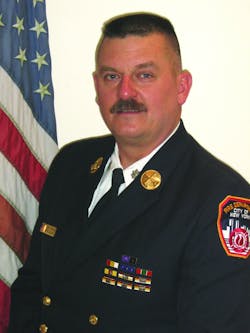Fire department operations at structural fires many times require the use of a second hoseline. There are a number of tactical assignments that this second line can take based on the location and intensity of the fire as well as the physical arrangement of the involved building and the exposures. Knowing just where the second line needs to be or where it will have the most effect on the operation is neither easy nor consistent. Let’s take a look at the second hoseline and what it can do for us at our next structural fire.
One of the first and most important tasks a second hoseline can take is as a backup line. The role of a backup line by definition is to get it into a position where it can back up, augment or protect the first attack hoseline. This is most often accomplished by stretching the second line via the same route and to the same position as the first line or the line it is being called to back up. The backup line may be needed for several reasons – to augment, protect or rescue the firefighters on the first line.
A backup line may be called to help the first hoseline push into a fire that is not being darkened down by the first hoseline. There are occasions when the first line is simply not delivering enough water to extinguish the volume of fire that exists. In this case, the backup line advances up to the position the first line is holding and they go into operation in unison, directing their streams into the same area, room or compartment.
The second backup duty for a hoseline is to protect the first line. The first attack hoseline may be in a position where it is operating on the fire, but the firefighters are being exposed and threatened by fire in another room or other area. In this situation, the backup line may be stretched to the same location or to another location where it can darken down the fire that is exposing the first nozzle team.
The third assignment the backup line may handle is to rescue the nozzle team. Any engine company nozzle team can push into or advance into conditions that the firefighters cannot control or they can be injured by. Engine firefighters occasionally fall through floors, have flaming debris or ceilings collapse on them or experience a flashover. A backup line may be required to extricate or save the members of the nozzle team should these conditions develop.
In addition to the backup duties, the second hoseline can be ordered into position for several other reasons and to several locations. The second line may be stretched to an exposure, to the floor above the fire or to any other area that fire may be extending to.
The second line should be stretched to the floor above the fire when the volume and intensity of the fire dictates. There is obviously a much greater chance of extension to the floor above in a frame building than in a fireproof or brick-and-joist structure, but fire can and will find its way to the floor above. A medium or heavy fire condition should prompt the incident commander to have the second line started toward the building in preparation for deployment to the floor above. The crew stretching that line should make sure it takes one or even two more hose lengths to the fire area than the firefighters on the first line did.
Exposure protection is another frequent assignment for the second hoseline. Again, depending on the location and intensity of the fire, the second line may need to be positioned as an exterior protection line or it may have to be stretched into the exposed building to make an interior attack there. When a line is being used exclusively as an exterior protection line, it should be a 2½-inch hoseline. If, on the other hand, the line will be used only momentarily as an exterior line and will then quickly move into the exposure for interior operations, 1¾-inch or 1½-inch hose should be used. This situation also requires the engine to pull additional lengths to cover the entire building.
The first hoseline is almost always the line that will locate, darken down and finally extinguish the main body of fire. The second hoseline, however, is often the line that prevents the fire from taking hold on the floor above the fire or in an adjacent exposure. Knowing where this line is needed, how many lengths will be required and how to get it there quickly makes the second hoseline a vital tool for the incident commander.
JOHN J. SALKA Jr., a Firehouse® contributing editor, is a 32-year veteran battalion chief with FDNY, the commander of the 18th battalion in the Bronx. Salka has instructed at several FDNY training programs, including the department’s Probationary Firefighters School, Captains Management Program and Battalion Chiefs Command Course. He conducts training programs at national and local conferences and has been recognized for his firefighter survival course “Get Out Alive.” Salka co-authored the FDNY Engine Company Operations manual and wrote the book First In, Last Out – Leadership Lessons From the New York Fire Department. He also operates Fire Command Training (www.firecommandtraining.com), a New York-based fire service training and consulting firm.






